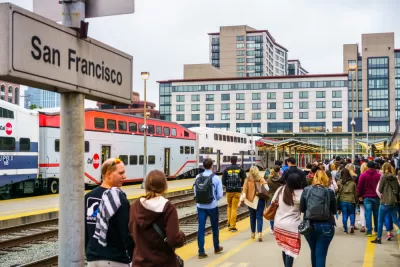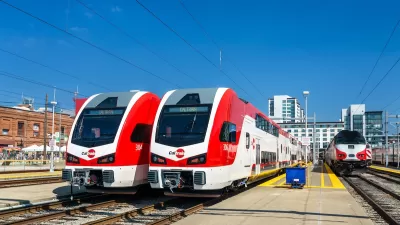The agency is seeking an additional $260 million to complete electrification of train lines between San Francisco and San Jose.

As Benjamin Schneider reports in the San Francisco Examiner, “Caltrain is on the cusp of completing its most significant upgrade since the rail line debuted in 1863. By converting its power source from fossil fuels to electricity, trains travelling between San Francisco and San Jose will be faster, more frequent and far less polluting.” But the agency needs an additional $260 million to finish the project by the target 2024 completion date.
“The project, which also includes a new signal system and other improvements, was originally budgeted for $1.9 billion, but costs ballooned to about $2.4 billion. The $462 million shortfall was partly the result of pandemic disruption, cost increases and unexpected construction issues along the nearly 160-year-old railway.” The project also had to replace its signal system to comply with federal and state standards. To secure the needed funding, “The agency’s best hope is at the state level where several Bay Area legislators have proposed a bill, AB 2197, that would appropriate $260 million to the project from the general fund.”
According to the article, electric trains will have higher frequency and more modern interiors. “Unlike today’s diesel trains, electrified Caltrain service will not produce any local pollution, so communities near the tracks will breathe cleaner air. The zero emissions trains are expected to decrease CO2 emissions by 176,000 tons annually.”
FULL STORY: Caltrain seeks $260 million to complete electrification

Alabama: Trump Terminates Settlements for Black Communities Harmed By Raw Sewage
Trump deemed the landmark civil rights agreement “illegal DEI and environmental justice policy.”

Study: Maui’s Plan to Convert Vacation Rentals to Long-Term Housing Could Cause Nearly $1 Billion Economic Loss
The plan would reduce visitor accommodation by 25% resulting in 1,900 jobs lost.

Planetizen Federal Action Tracker
A weekly monitor of how Trump’s orders and actions are impacting planners and planning in America.

Waymo Gets Permission to Map SF’s Market Street
If allowed to operate on the traffic-restricted street, Waymo’s autonomous taxis would have a leg up over ride-hailing competitors — and counter the city’s efforts to grow bike and pedestrian on the thoroughfare.

Parklet Symposium Highlights the Success of Shared Spaces
Parklets got a boost during the Covid-19 pandemic, when the concept was translated to outdoor dining programs that offered restaurants a lifeline during the shutdown.

Federal Homelessness Agency Places Entire Staff on Leave
The U.S. Interagency Council on Homelessness is the only federal agency dedicated to preventing and ending homelessness.
Urban Design for Planners 1: Software Tools
This six-course series explores essential urban design concepts using open source software and equips planners with the tools they need to participate fully in the urban design process.
Planning for Universal Design
Learn the tools for implementing Universal Design in planning regulations.
Caltrans
Smith Gee Studio
Institute for Housing and Urban Development Studies (IHS)
City of Grandview
Harvard GSD Executive Education
Toledo-Lucas County Plan Commissions
Salt Lake City
NYU Wagner Graduate School of Public Service





























